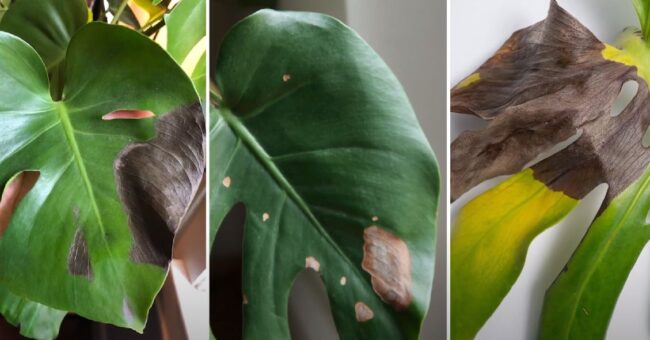Bacterial black leaf spot on Monstera is a common issue faced by plant lovers. If you’ve noticed dark, irregular spots on your Monstera’s leaves, worry not! In this article, we will explore the cause of this problem and provide you with effective solutions to combat it.
Whether you are an experienced gardener or a beginner, understanding and addressing bacterial black leaf spot on Monstera is essential to ensure the health and vitality of your beloved plant.
So, let’s dive in and learn how to keep your Monstera thriving!
Bacterial Black Leaf Spot on Monstera: A Comprehensive Guide
Monstera plants, with their iconic large, glossy leaves, are popular among indoor gardeners. However, these beautiful plants are not immune to diseases and pests. One common issue that can affect Monstera plants is bacterial black leaf spot.
In this article, we will delve into the details of bacterial black leaf spot on Monstera, including its causes, symptoms, prevention, and treatment options.
What is Bacterial Black Leaf Spot?
Bacterial black leaf spot, also known as Xanthomonas campestris, is a disease caused by bacteria that affects the foliage of Monstera plants. This bacterial infection leads to the development of dark, water-soaked spots on the leaves, typically starting at the edges or tips and spreading inward.
If left untreated, these black spots can expand and cover the entire leaf, eventually causing it to wither and die.
Causes of Bacterial Black Leaf Spot
Bacterial black leaf spot is caused by the bacterium Xanthomonas campestris, which can be introduced to Monstera plants through various means. The primary causes of this bacterial infection include:
1. Poor Plant Hygiene: Contaminated tools or hands can transfer the bacteria from infected plants to healthy ones. It is crucial to practice proper hygiene when handling plants, especially if you suspect any signs of bacterial infection.
2. Overwatering: Excessive moisture on the foliage creates a favorable environment for bacteria to thrive. Overwatering Monstera plants can weaken their resistance to diseases, making them more susceptible to bacterial black leaf spot.
3. Crowded Conditions: Plants that are overcrowded or have poor air circulation are more prone to bacterial infections. It is essential to provide adequate spacing between Monstera plants to prevent the spread of bacteria.
Symptoms of Bacterial Black Leaf Spot
To effectively identify and treat bacterial black leaf spot on your Monstera plant, it is crucial to understand its symptoms. The following signs indicate the presence of this bacterial infection:
1. Black Spots on Leaves: The most apparent symptom of bacterial black leaf spot is the development of black or dark brown spots on the leaves. These spots may start small but gradually increase in size and merge with each other.
2. Water-Soaked Appearance: Initially, the spots may appear water-soaked, giving them a wet, slimy appearance. As the infection progresses, the spots may become dry and crinkly.
3. Yellowing and Wilting: Infected leaves may exhibit yellowing or browning around the black spots. Eventually, the affected leaves may wilt and die.
Preventing Bacterial Black Leaf Spot
Prevention is key when it comes to managing bacterial black leaf spot on Monstera plants. By following these preventive measures, you can reduce the risk of infection:
1. Sanitize Tools: Disinfect your gardening tools, including pruning shears and scissors, before and after each use to prevent the spread of bacteria.
2. Maintain Good Plant Hygiene: Regularly inspect your Monstera plants for any signs of disease or pests. If you notice any infected leaves, promptly remove and dispose of them to prevent the spread of bacteria.
3. Optimize Watering Practices: Avoid overwatering your Monstera plants. Instead, water them when the top inch of soil feels dry. Ensure proper drainage to prevent waterlogged conditions that can promote bacterial growth.
4. Provide Adequate Air Circulation: Ensure sufficient spacing between your Monstera plants to promote air circulation. This allows the foliage to dry out faster, reducing the risk of bacterial infections.
Treating Bacterial Black Leaf Spot
If your Monstera plant is already infected with bacterial black leaf spot, take immediate action to prevent further spread. Here are some treatment options:
1. Isolate the Infected Plant: Remove the infected Monstera plant from other healthy plants to contain the bacteria. This prevents the infection from spreading throughout your garden.
2. Prune Infected Leaves: Carefully prune the infected leaves, ensuring to sanitize your tools between cuts. Dispose of the infected foliage in sealed bags or burn them to prevent bacterial reinfection.
3. Copper-Based Fungicides: Copper-based fungicides can help control bacterial infections. Follow the manufacturer’s instructions for application, as excessive use can cause leaf burn.
4. Improve Air Circulation: Enhance air circulation around your Monstera plant by placing it in a well-ventilated area. This helps the leaves dry out faster and inhibits bacterial growth.
5. Adjust Watering Techniques: Ensure proper watering by allowing the soil to partially dry between waterings. Avoid overhead watering, as it can contribute to the spread of bacteria.
Bacterial black leaf spot can be a frustrating issue for Monstera plant owners, but with proper care and preventive measures, its impact can be minimized. By maintaining good plant hygiene, optimizing watering practices, and providing adequate air circulation, you can significantly reduce the risk of bacterial infections.
If your Monstera does get infected, prompt action, such as isolating the plant and using appropriate treatments, can help control the spread and save your plant from further damage. With diligence and care, you can ensure your beloved Monstera plants thrive and remain free from bacterial black leaf spot.
Frequently Asked Questions (FAQs)
Bacterial black leaf spot is a common disease that affects Monstera plants. It is characterized by black or dark brown spots on the leaves, which can gradually enlarge and merge together. The spots may have a greasy appearance and can eventually cause the affected leaves to wither and die.
Bacterial black leaf spot is caused by the pathogenic bacteria Xanthomonas campestris. It usually enters the plant through wounds or natural openings, such as stomata. Overwatering, high humidity, and poor air circulation can create favorable conditions for the bacteria to thrive and infect the leaves.
To prevent bacterial black leaf spot, it’s important to maintain proper plant care practices. Avoid overwatering and ensure good drainage to prevent excess moisture. Improve air circulation around the plant by placing it in a well-ventilated area.
Wiping the leaves occasionally with a clean, damp cloth can also help remove any dust or debris that can harbor bacteria.
Treating bacterial black leaf spot involves a combination of cultural practices and, in severe cases, the use of copper-based bactericides. Start by removing and destroying infected leaves to prevent the spread of bacteria.
Ensure your plant receives adequate sunlight and avoid wetting the foliage during watering. If necessary, consult a professional or local agricultural extension for appropriate bactericide recommendations.
Yes, if the infected Monstera plant comes into contact with other susceptible plants, the bacteria can spread. It is essential to isolate the infected plant and avoid sharing tools or equipment without proper sanitization.
Regularly monitor nearby plants for any signs of infection and take appropriate measures if detected.
In cases of severe bacterial black leaf spot, it can be challenging to save the affected plant. However, by following proper cultural practices and providing optimal growing conditions, you may be able to control the disease and prevent its spread.
It’s important to remove and destroy severely infected leaves and consult with a plant specialist for additional guidance.
No, bacterial black leaf spot on Monstera is not contagious to humans or pets. It is a plant-specific disease caused by Xanthomonas campestris and does not pose any health risks to humans or animals.
Since bacterial black leaf spot is caused by bacteria and not fungi, fungicides are generally ineffective in controlling this disease. Copper-based bactericides, however, may help suppress bacterial growth and limit the spread of the infection. It is important to carefully follow the instructions provided with the bactericide and use it only as directed.
Final Thoughts
Bacterial black leaf spot on Monstera is a common issue that affects the health and appearance of these beautiful plants. The black spots on the leaves are caused by bacteria, which can spread and damage the entire plant if left untreated. To combat this problem, it is important to take preventive measures such as maintaining proper humidity levels and avoiding overwatering.
If your Monstera is already affected, remove the affected leaves and treat them with a suitable bactericide. Regularly inspecting your plant and providing it with proper care will help keep bacterial black leaf spot at bay.
Auto Amazon Links: No products found.
Perfect Plants Christmas Tree Saver 8oz. | Easy Use Xmas Tree Preserver Food | Have Healthy Green Christmas Trees All Holiday Season
$9.97 (as of December 3, 2025 00:36 GMT +00:00 - More info- Product prices and availability are accurate as of the date/time indicated and are subject to change. Any price and availability information displayed on [relevant Amazon Site(s), as applicable] at the time of purchase will apply to the purchase of this product.
Kaiedos Christmas Tree Watering Funnel - 39 Inch Funnel, Reusable Design, Makes Watering Your Live Tree a Snap!
$14.99 (as of December 3, 2025 00:36 GMT +00:00 - More info- Product prices and availability are accurate as of the date/time indicated and are subject to change. Any price and availability information displayed on [relevant Amazon Site(s), as applicable] at the time of purchase will apply to the purchase of this product.
Christmas Tree Watering Funnel, Real Christmas Tree Water Long Funnel About 40 Inch, Trees Watering System for Water Indoor Outdoor
$15.99 (as of December 3, 2025 00:36 GMT +00:00 - More info- Product prices and availability are accurate as of the date/time indicated and are subject to change. Any price and availability information displayed on [relevant Amazon Site(s), as applicable] at the time of purchase will apply to the purchase of this product.
IPOOLTENG Christmas Tree Watering Funnel 3 Tube 1 Funnels 40 Inch - 3 Section Plastic Christmas Tree Funnel Waterer, Long Funnels for Watering Trees, Best Gifts for Your Parents to Water Tree
$15.53 (as of December 3, 2025 00:36 GMT +00:00 - More info- Product prices and availability are accurate as of the date/time indicated and are subject to change. Any price and availability information displayed on [relevant Amazon Site(s), as applicable] at the time of purchase will apply to the purchase of this product.
1 Pack Christmas Tree Watering Funnel System, 44 Inch Christmas Tree Watering Stick with Adjustable 3-Section Design, Reusable & Spill-Free, Xmas Plant Waterer Tool for Indoor and Outdoor
$16.99 (as of December 3, 2025 00:36 GMT +00:00 - More info- Product prices and availability are accurate as of the date/time indicated and are subject to change. Any price and availability information displayed on [relevant Amazon Site(s), as applicable] at the time of purchase will apply to the purchase of this product.
Cuisinart 6.5" Cast Iron Smashed Burger Press, Round Flat Edge Grill Press for Crispy Smash Burgers, Burger Tool for Grill and Griddle Accessories, for BBQs and Tailgates
$9.99 (as of November 30, 2025 15:21 GMT +00:00 - More info- Product prices and availability are accurate as of the date/time indicated and are subject to change. Any price and availability information displayed on [relevant Amazon Site(s), as applicable] at the time of purchase will apply to the purchase of this product.
Muddy Mat® Shown on TV Super Absorbent Microfiber Dog Door Mat for Muddy Paws, Non-Slip Washable Pet Rug, Quick Dry Chenille Entryway Carpet, Machine Washable Indoor Outdoor mat, Grey 30"x19"
$18.78 (as of November 30, 2025 15:21 GMT +00:00 - More info- Product prices and availability are accurate as of the date/time indicated and are subject to change. Any price and availability information displayed on [relevant Amazon Site(s), as applicable] at the time of purchase will apply to the purchase of this product.
Zevo Flying Insect Trap Official Refill Cartridges - Fits Both Zevo Trap & MAX Indoor Fly Trap - Authentic Trap+Lock Technology to Catch Gnats, House & Fruit Flys (4 Official Refill Cartridges)
$14.97 (as of November 30, 2025 15:21 GMT +00:00 - More info- Product prices and availability are accurate as of the date/time indicated and are subject to change. Any price and availability information displayed on [relevant Amazon Site(s), as applicable] at the time of purchase will apply to the purchase of this product.
ThermoPro TP16 Large LCD Digital Cooking Food Meat Thermometer for Smoker Oven Kitchen BBQ Grill Thermometer Clock Timer with Stainless Steel Temperature Probe
$17.99 (as of November 30, 2025 15:21 GMT +00:00 - More info- Product prices and availability are accurate as of the date/time indicated and are subject to change. Any price and availability information displayed on [relevant Amazon Site(s), as applicable] at the time of purchase will apply to the purchase of this product.
TERRO Ant Killer Bait Stations T300B - Liquid Bait to Eliminate Ants - Bait System - 12 Count Stations for Effective Indoor Ant Control
$10.86 (as of November 30, 2025 15:21 GMT +00:00 - More info- Product prices and availability are accurate as of the date/time indicated and are subject to change. Any price and availability information displayed on [relevant Amazon Site(s), as applicable] at the time of purchase will apply to the purchase of this product.











